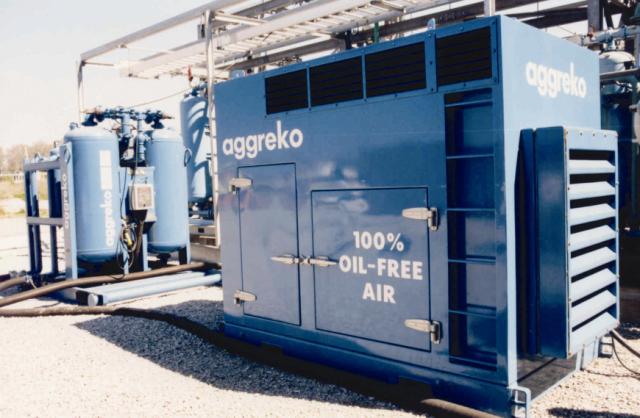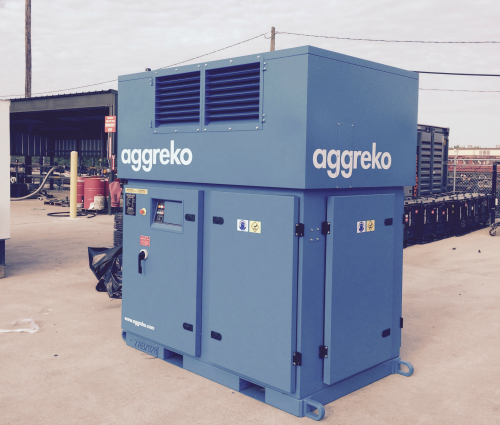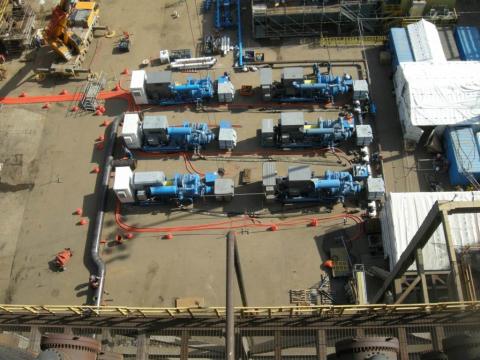Compressed Air Best Practices® Magazine spoke with Mark Shedd, Head of Oil-free Air, Aggreko Rental Solutions
CABP: It’s great to talk to you again Mark. Can you remind us why refineries and petrochemical plants require oil-free compressed air?
It’s great to talk with you also. There are two distinct compressed air systems in a refinery or petrochemical environment: plant air and instrument air systems. Instrument air systems are almost always 100% oil-free air compressors on both the permanent and temporary systems. The demand for compressed air purity, in instrument air systems, is so high that the permanent install back-up system is usually nitrogen.
Most instrumentation control circuits use compressed air-actuated valves. When the actuator articulates, a tiny orifice will bleed the air down so the spring can overcome the actuator and close the valve or whatever its function may be. Any level of oil carryover, from a flooded compressor air compressor for example, will mix with water vapor, emulsify, then coagulate and finally plug the actuator orifices. When the orifice is clogged, the actuator will no longer function and it cannot relieve a control air circuit.
One of the largest catastrophes in the refining world, where there was a significant explosion, was traced back to an actuator not closing a valve and chemicals mixing- which shouldn’t mix. The contaminated control air circuit did not allow a critical valve to close. This is why, most refiners not only use oil-free air compressors for their Instrument Air – but use their pure nitrogen systems (rather than plant air) as the back-up.
CABP: What kind of pressure dew point requirements do the refiners have? Is it still – 40 °F ?
Yes, most applications require a – 40 °F (– 40 °C) pressure dew point. There are, however, a good many applications requiring – 100 °F (– 73 °C). For example, Aggreko is called in to assist with the pneumatic conveyance in the de-inventorying and re-inventorying of catalyst from a reactor. A lot of this catalyst is hygroscopic, so no detectable moisture in the compressed air stream is allowed.
We use pressure-swing (also known as heatless) desiccant air dryers due to their proven ability to reach and maintain very low dew points. We do not use heated desiccant dryers as they require electrical hook-ups and create greater kW demands.
We recently we had a -128 °F (-88 °C) pressure dew point requirement because it was part of a catalyst process. For this extremely low dew point, we engineered a solution, which included pre-cooling the compressed air (by chilling it) before it hit the desiccant dryer.

Instrument air purity requirements are met by oil-free air compressors and heatless desiccant air dryers
CABP: What kind of technical support and remote monitoring/control capabilities does Aggreko offer?
Technical support represents a unique thing about Aggreko - we aren’t just a rental company. As you know, I’ve been doing this for 20+ years and have long-standing relationships with all the major refiners. Sometimes, however, we get an inquiry that I can’t handle technically and it’s amazing to have a full staff of chemical, mechanical, and process engineers in our Process Services team to turn to. These folks can engineer any solution to any problem- similar to the --128 °F (-88 °C) pressure dewpoint requirement mentioned earlier. We are head and shoulders over most rental companies in engineering capacities.
Aggreko has been an industry leader with regards to remote operational control and monitoring. The Remote Operating Center (ROC) is an impressive control room, very similar to a refinery or NASA control room. Staffed by our operators 24 hours per day, they are able to provide constant monitoring and offer live technical support to customers. We also give the customer the ability to remotely monitor our air compressors and cooling solutions from their control room - by tying them into our systems. Due to the critical nature of the applications, remote monitoring is designed to supplement in-person maintenance rounds and procedures-not replace them.

The Aggreko Remote Operating Center provides 24/7 vigilance
CABP: Please describe the catalyst regeneration process and Aggreko’s role.
Oil refineries often face the need for temporary increases in capacity. The most common demand driver is for gasoline, during the summer months The increased throughput will cause an earlier fatigue of catalyst. The catalyst regeneration process, in an oil refinery, uses compressed air to purge vessels and to regenerate the catalyst. Scheduled and emergency outages, at the refinery, result in temporary demand for “ Oil-Free” compressed air in the catalyst regeneration process.
The large, upright vessels, such as distillation columns and vacuum flashers, also require periodic maintenance. These vessels have many trays where moisture will accumulate when opened to atmosphere. The moisture must be removed from the steel towers prior to being put back into service. Hot nitrogen, sometimes produced on-site but more often supplied by trucked-in pumper units, is used to purge the vessels of moisture.
Compressed air is a more cost-effective method of purging the vessels of moisture in any process where the introduction of oxygen does not create a safety hazard. Often, oil-free compressed air can be introduced while workers are present to maintain a positive pressure and minimize the entry of moisture in the repair and inspection phase. This cannot be accomplished with nitrogen as it will create a nitrogen rich environment unsafe to workers. During a turnaround, there are many opportunities to utilize clean Class 0, 100% oil-free compressed air:
- Purging a vessel or confined space to allow access for personnel
- Cool-down of reactors after an initial purge of hydrocarbons-providing quicker access for personnel
- Continuous supply of Class 0, 100% oil free air while personnel are inside a confined space to create an environment which will minimize the required exiting of the vessel and breaks in productivity of personnel.
- De-inventory of spent catalyst, bulk conveyance of new catalyst, conditioning of vessel for hygroscopic catalyst (maintaining RH)
- Conditioning of space during cleaning process of trays and reactor walls to minimize flash rust of exposed metal
- Cost of nitrogen and the logistical hurdles of moving pump trucks in and out of the space during the scheduled outage can be mitigated by doing a single purge with Nitrogen (in an Oxygen sensitive process) and the continuous purge being performed with clean dry compressed air
Temporary Air Compressors Enable Upgrader to Resume Coker OperationThe main air blower, for the furnace at a synthetic crude plant’s 85,000 barrel per day coker unit, suffered a mechanical blade failure just prior to a scheduled turnaround. The coker furnace is a forced draft heater utilizing a 158,300 scfm main air blower. Discharge from the blower is used as combustion air in the coker furnace. A turnaround had been scheduled for the coker, about a week before the failure occurred. However, since it was no longer possible to run the blower, the coker had to shut down prematurely. This was a major concern since it was highly unlikely the repair of the air blower would be completed by the restart date of the coker, resulting in a significant loss of production. Aggreko provided air compressors that delivered 150,000 scfm of oil-free air, 33 MW of power, 2000 tons of cooling tower capacity, 56 pieces of electrical distribution equipment (transformers/breakers/panels) and low voltage 480 V cable. Aggreko assigned a senior engineer as project manager and deployed technicians to manage onsite activities, 24 hours a day, at key locations throughout the upgrader. Aggreko, in conjunction with plant personnel, also coordinated mobilization, installation, and commissioning of all phases of the project. The Aggreko solution allowed the customer to maintain maximum feed rates. The temporary equipment systems operated for 18 days, until it was transferred to the repaired equipment without any service interruptions. The Aggreko solution allowed the customer to maximize feedstocks and averted a potential loss of \$50M dollars (US).
Aggreko supplied 150,000 scfm of oil-free compressed air to supplant a failed main air blower at a synthetic crude plant. |
CABP: Can you describe how the Main Air Blowers are used and how you supplement their work in de-coking the catalyst in a “cat cracker”?
Sure. We just completed a 70,000 cfm project for a refiner where they lost a main blower to their cat cracker. We provided this compressed air flow (and the power to run it) in a manner of weeks. In order to regenerate the catalyst in a “cat cracker” vessel, the catalyst must be “de-coked”. “De-coking” is the process where catalyst residue is burned. This can only occur when oxygen is introduced, to increase the temperature of the burn, which then permits the burning of catalyst residue. Oil-free compressed air is used to introduce the required levels of oxygen.
Refineries have main air blowers supplying air to the entire facility. Rental oil-free air is often used to supplement the volume of air required, or to ensure redundancy for the refinery. When ambient temperatures go up and oxygen content goes down, compressed air is fed into the intake of the main air blower. This is a more cost-effective supplementation method, to maintain oxygen levels, than using liquid oxygen.
Refineries have 100% redundancy requirements for their main air blower systems. A refinery cannot produce without the main air blower system so it is therefore a critical application. A shutdown, of course, will cost the refinery millions of dollars per minute. If repairs are needed on the air blower, rental oil-free compressed air will be brought in to replace it during repair. The back-up blowers are thereby maintained in reserve to ensure redundancy.
CABP: How do you decide whether to use a rotary screw or a centrifugal air compressor?
More often than not, the main air blower is typically a large steam or gas turbine driven centrifugal unit. If we are addressing an ambient temperature change where the blower an no longer provide the required pounds per minute of oxygen, we’ll bring in rotary screws to augment up to 6000 cfm. Above 6000 cfm, we will evaluate if we should bring in a centrifugal which has the ability to part-load…if their rates fluctuate then we can fluctuate the augmented demand. This is where our process engineering and customer knowledge makes a huge difference. We work with the client to forecast oxygen demand and fluctuation rates on this demand to select the best temporary compressed air supply strategy for them.
Aggreko’s fleet normally has the capacity to deliver 800,000 to 1 million cfm. To supplement our fleet of oil-free rotary screw air compressors, Aggreko has now developed a contractual relationship with a niche provider of rental centrifugal air compressor skids. They do the project engineering and we are their sales channel. We now have the largest rental fleet on the market. The 70,000 cfm project mentioned before was provided in a manner of weeks. We can normally provide a turnkey system in no longer than a month-and that’s the longest it’s ever taken us in my 20+ years.
CABP: When is the “right” time for temporary vs. permanent install compressed air systems?
That’s a great question and what we focus on answering with our clients. It’s all about maximizing their use of capital, minimizing energy consumption and being able to react to changes in market demand.
Chemical plants have seen upticks in demand for ammonia production. They contact us for augmentation, because they can’t increase their “feed air” fast enough to keep up.
These calls come to us when they recognize they are “feed air limited” to their process. Normally it’s a mass flow application. Their engineering staff will say they need “x” amount of pounds per hour of additional oxygen for the process. The feed air is a fuel gas where oxygen is being burned as a fuel to create heat or they are using oxygen on a molecular level to blend with their product.
Our process engineering team will design a temporary solution to meet the oxygen needs. If the market “uptick” opportunity is less than 3 years, they don’t want to put in permanent equipment. The lead times to procure new permanent equipment of this volume are also not short – and the chemical plant doesn’t want to miss the market opportunity. So, it’s normal to use our temporary products to integrate into their permanent install system.
Then, of course, there’s always the failure event where they need the immediate response, where we can recreate their permanent install systems. There was a lot of deferred, maintenance over the past years, and we are now seeing business as a result. Here’s a quick list of common situations where we are called in:
- Redundancy for permanent install during unexpected breakdowns
- Augmentation for permanent install to address seasonal inefficiencies or mechanical inefficiencies
- Identifying a market trend for a specific finished product requiring additional capacity
- Curtailing the capacity of the permanent install fixed horsepower machines: right -sizing to demand in a market downturn

Aggreko can rapidly design and deliver an electric driven oil-free air compressor system from 400 – 30,000 ACFM in a single machine.
CABP: How does Aggreko align its product offering to help clients optimize their supply strategy to match their demand profiles?
The challenges our clients face is their demand-profiles have huge fluctuations. We have a Certified Air Master working on our engineering team and independent auditors do call us. We will assist them and our customers on the question of how they balance permanent with temporary install equipment to optimize capital and energy use.
As mentioned, we have longstanding relationships with most of the major refineries. We recognize what the market conditions are for them. We know there isn’t a big market for benzyne right now, for example, and have a client with 5000 horsepower worth of permanent install air compressors which are severely under-loaded. We went in to right-size their supply by offering them a temporary solution matching their load much better.
Our new diesel product has the ability to speed modulate and we are planning to introduce a variable frequency drive into our electric air compressor range in 2017.
We can reconfigure our centrifugal rental fleet to configure the motor to reduce blow-off. We have the ability to change impellers, use two-stages instead of three, and custom-select motors all to help clients match supply up better with demand.
CABP: Temporary cooling solutions with rental chillers and cooling towers is a big part of your business. Is there cross-over with compressed air applications?
I’m glad you asked that question. There are a lot of interesting things happening here. As you know, with air compressors most of the energy is lost to the heat of compression. We are working on a prototype heat recovery unit. The idea is to equip our standard air compressors with the option to bypass our aftercoolers and reroute the 2nd stage 400 F compressed air to a heat exchanger to be used in the customers process.
Our process engineers currently do a lot of this work, deploying our temporary cooling products, so we have a lot of knowledge on the opportunities here. Right now we are looking at a long-term opportunity with a customer. Again, we aren’t a transactional rental company – we are a specialty provider of all things infrastructure to our clients.
CABP: Thank you for your time.
For more information please contact Mark Shedd, Head of OFA, Aggreko Rental Solutions, tel: 281-412-1811, email: mark.shedd@aggreko.com, www.aggreko.com/northamerica.
To read similar Oil & Gas Industry articles, please visit www.airbestpractices.com/industries/oil-gas.





